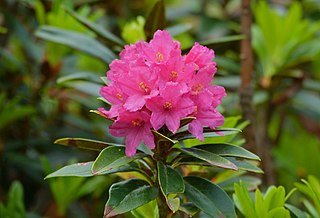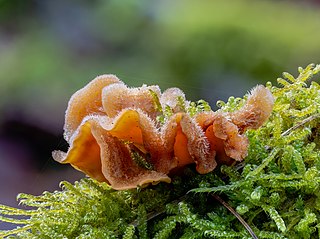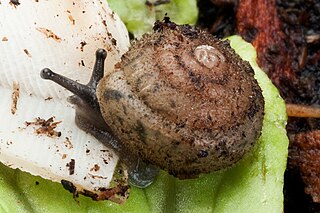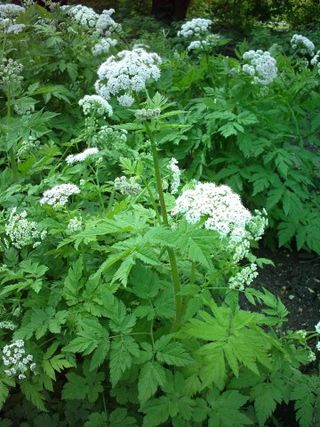
Gossypium is a genus of flowering plants in the tribe Gossypieae of the mallow family, Malvaceae, from which cotton is harvested. It is native to tropical and subtropical regions of the Old and New Worlds. There are about 50 Gossypium species, making it the largest genus in the tribe Gossypieae, and new species continue to be discovered. The name of the genus is derived from the Arabic word goz, which refers to a soft substance.

Rhododendron ferrugineum, the alpenrose, snow-rose, or rusty-leaved alpenrose is an evergreen shrub that grows just above the tree line in the Alps, Pyrenees, Jura and northern Apennines, on acid soils. It is the type species for the genus Rhododendron.

Gossypium barbadense is one of several species of cotton. It is in the mallow family. It has been cultivated since antiquity, but has been especially prized since a form with particularly long fibers was developed in the 19th century. Other names associated with this species include Sea Island, Egyptian, Pima, and extra-long staple (ELS) cotton.

Gossypium hirsutum, also known as upland cotton or Mexican cotton, is the most widely planted species of cotton in the world. Globally, about 90% of all cotton production is of cultivars derived from this species. In the United States, the world's largest exporter of cotton, it constitutes approximately 95% of all cotton production. It is native to Mexico, the West Indies, northern South America, Central America and possibly tropical Florida.

Stereum hirsutum, commonly known as the false turkey tail, hairy stereum, or hairy curtain crust, is a fungus typically forming multiple brackets on dead wood. It is also a plant pathogen infecting peach trees. S. hirsutum is in turn parasitised by certain other species such as the fungus Tremella aurantia. Substrates for S. hirsutum include dead limbs and trunks of both hardwoods and conifers.
Stenotrema hubrichti is a species of air-breathing land snail, a terrestrial pulmonate gastropod mollusc in the family Polygyridae. This species is endemic to the United States.

Stenotrema is a genus of air-breathing land snails, terrestrial pulmonate gastropod molluscs in the family Polygyridae. These are typically small to medium-sized snails, with a velvety or hairy shell surface, and a narrow aperture which is usually closely guarded by well-developed "teeth".
Rich Mountain slitmouth or Pilsbry's narrow-apertured land snail, scientific name Stenotrema pilsbryi, is a species of air-breathing land snail, a terrestrial pulmonate gastropod mollusc in the family Polygyridae. This species is endemic to Ouachita Mountains of the United States.

Polygyridae is a family of air-breathing land snails, terrestrial pulmonate gastropod mollusks in the superfamily Helicoidea.

Epilobium hirsutum is a flowering plant belonging to the willowherb genus Epilobium in the family Onagraceae. It is commonly known as the great willowherb, great hairy willowherb or hairy willowherb. Local names include codlins-and-cream, apple-pie and cherry-pie.

Euchemotrema is a genus of small, air-breathing land snails, terrestrial pulmonate gastropod molluscs in the family Polygyridae.

Rhododendron hirsutum, commonly known as the hairy alpenrose is one of the species of Rhododendron native to the mountains of Europe. It occurs widely in the Alps except for the southwestern region, and has become naturalised in parts of the Carpathians. It grows on carbonate-rich soils, whereas its close relative R. ferrugineum grows on acid soils; where the two occur together, they frequently produce the hybrid Rhododendron × intermedium.
British NVC community OV26 is one of the open habitat communities in the British National Vegetation Classification system. It is one of four tall-herb weed communities.

Lotus hirsutus, also known by the synonym Dorycnium hirsutum, common name: canary clover or hairy canary-clover, is a species of flowering plant in the legume family Fabaceae.

Hypericum hirsutum is a species of flowering plant in the family Hypericaceae, commonly known as hairy St John's-wort. It is found in Western Europe.

Trichoglossum hirsutum is a species of fungus in the family Geoglossaceae. In the UK, it has been given the recommended English name of hairy earthtongue. In North America it is known variously as velvety black earth tongue, velvety earth tongue, shaggy earth tongue, or black earth tongue. DNA evidence suggests the hairy earthtongue may be a species complex.

Vaccinium hirsutum is a species of flowering plant in the heath family known by the common name hairy blueberry. This species is endemic to a small area in the southern Appalachian Mountains, where it is only known from a few counties in eastern Tennessee, northern Georgia, and the Carolinas.

Canarium hirsutum is a tree in the family Burseraceae. The specific epithet hirsutum comes from the Latin meaning "bristly", referring to the rough hairs of the fruit.

Chaerophyllum hirsutum, hairy chervil, is a species of flowering plant belonging to the parsley family Apiaceae.
Stenotrema calvescens, common name Chattanooga slitmouth, is a species of air-breathing land snail, a terrestrial pulmonate gastropod mollusc in the subfamily Triodopsinae of the family Polygyridae.

















